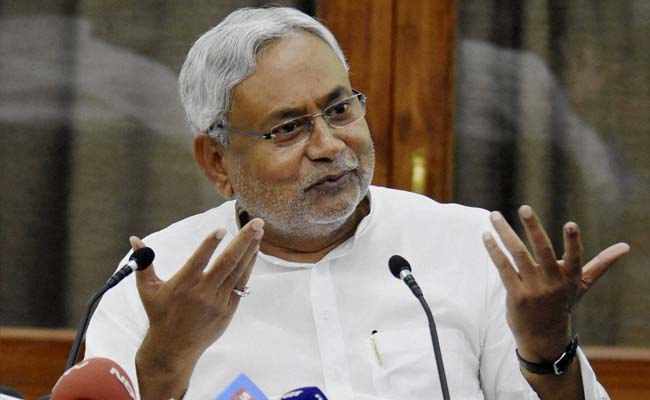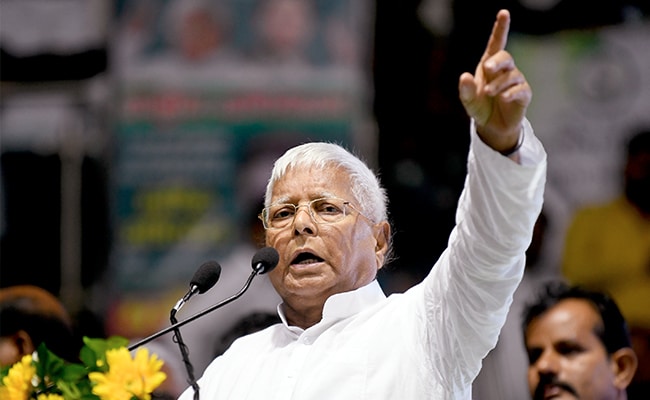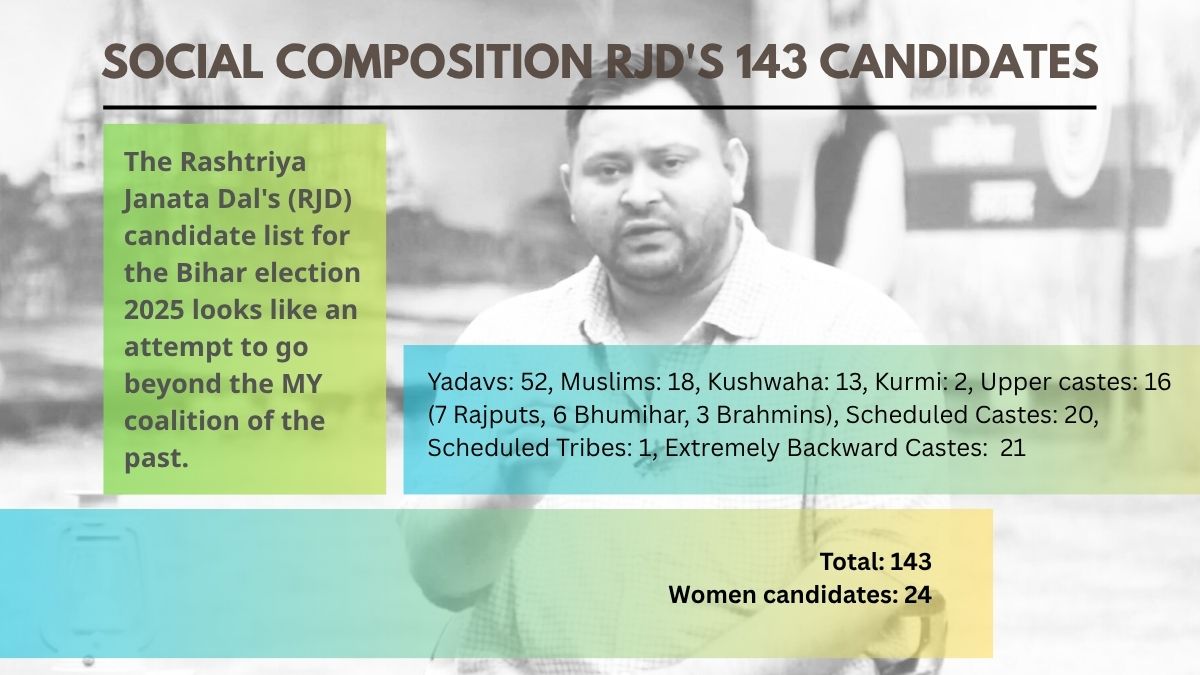
- RJD aims to expand beyond Muslim-Yadav base with PDA (Pichde, Dalits and Alpasankhyak) support
- RJD dropped 36 MLAs for non-performance in new candidate list of 143 seats
- RJD allocated 24 tickets to women amid rising female voter turnout in Bihar
In the intricate smorgasbord of Bihar's political landscape, the Rashtriya Janata Dal (RJD) has long stood as a formidable player, its roots entrenched in the soil of the Muslim-Yadav coalition. This coalition, often referred to as the MY alliance, has been both a foundational strength and a limiting weakness for the party. Historically, the RJD's social base helped it to command a significant portion of the electorate, yet this very reliance on a specific demographic confined it to a ceiling of approximately 30 per cent of the vote share.
Being part of the Mahagathbandhan alliance and contesting from only 144 seats (in 2020) reduces that vote share considerably. However, as the political clock ticks towards the 2025 Bihar assembly elections, Tejashwi Yadav, the party's leader, appears poised to chart a new course - one that seeks not just to reinforce existing alliances but to broaden the RJD's appeal across a more diverse electorate.
Much of the political reporting has hammered the Mahagathbandhan because of the friendly fights in some key constituencies between allies such as the RJD, the Congress, the Left and the VIP. But the strategic shift by the RJD, which can result in the expansion of the social base, has been missed by most reporters.

How Akhilesh's PDA Influenced Tejashwi
The backdrop of this strategic shift is marked by lessons learned from the past, notably from the successes and setbacks of contemporaries such as former chief minister and Samajwadi Party leader Akhilesh Yadav in Uttar Pradesh. Akhilesh Yadav's phenomenal success during the 2024 Lok Sabha indicates that such a shift in strategy might pay handsome dividends.
Tejashwi Yadav's new approach, which can be aptly termed the PDA strategy - encompassing Pichde (backward castes), Dalits, and Alpasankhyak (minorities) plus upper castes - reflects an acute awareness of Bihar's evolving socio-political dynamics. This strategy not only aims to reclaim lost ground but also to dismantle the entrenched stronghold of rivals like Nitish Kumar, who has adeptly navigated the caste complexities to build his own coalition of Mahadalits and Ati Pichde (Extremely Backward Classes).
RJD Drops 36 MLAs For Non-Performance
The recently announced candidate list for the 2025 elections encapsulates this transformative vision. By fielding 143 candidates, a slight reduction from the 144 in 2020, the RJD is making a calculated move. The decision to drop 36 MLAs (25.17 per cent) for non-performance signals an organisational introspection rarely seen in the party's past. It indicates a readiness to pursue winnability and assessment based on performance over loyalty, an essential shift in a political ecosystem often mired in patronage.

24 RJD Tickets For Women
The RJD has given tickets to 24 women candidates, considering that in the last few elections more women were turning out to vote compared to men. Since 1962, women's turnout has risen by 28 percentage points, effectively reversing the gender gap at the ballot box and establishing women as one of the most powerful voting blocs in Bihar today.
The male-female shift began in 2010, a historic turning point in Bihar's gender voting dynamics. That year, women's voter turnout surpassed men's in 162 constituencies. It was the first time that overall female turnout exceeded male turnout. In 2010, 54 per cent of women voted, surpassing the 51 per cent turnout among men for the first time. In 2015, the gap widened further, with 60 per cent of women voting compared to just 50 per cent of men.
In the 2020 assembly elections, women outvoted men in 167 of the 243 constituencies, especially in North Bihar. And the region leaned heavily towards the National Democratic Alliance (NDA). In 2020, despite elections being held during the coronavirus pandemic, 6 per cent more women turned out compared to men. Also, Chief Minister Nitish Kumar, because of his various women-centric schemes, seems to have a 32 per cent gender gap advantage over Tejashwi Yadav, according to a recent pre-poll survey.
Changing Social Composition Of RJD MLA Candidates
Among the noteworthy candidates are Tejashwi Yadav himself, contesting from Raghopur, alongside prominent figures like Chandra Shekhar from Madhepura and Veena Devi from Mokama. Each of these selections embodies the new strategic ethos of the RJD, which now extends its reach beyond the traditional Yadav-Muslim base. Indeed, 52 of the candidates still belong to the Yadav caste, and 18 are Muslims, but a significant restructuring has emerged that seeks to engage with other communities.

In this election cycle, the RJD has allocated 13 seats to the Kushwaha castes and two to the Kurmi castes - both traditionally aligned with Nitish Kumar. This strategic encroachment is not merely a tactical manoeuvre; it represents a broader ambition to fracture the existing caste alliances that have long dominated Bihar politics. Furthermore, the inclusion of 16 upper caste candidates - comprising Rajputs, Bhumihars, and Brahmins - further underscores Tejashwi Yadav's commitment to appealing to a more expansive voter base. In the past, Rajputs have shown a greater preference for the RJD. Still, Bhumihars and Brahmins shirked away from the RJD ever since Lalu Prasad Yadav's infamous slogan "Bhure bal saaf karo (get rid of upper castes)."
Tejashwi Yadav Goes Beyond Lalu Yadav's Social Base
Tejashwi Yadav, in full control of the RJD today, has decided to change his strategy, go beyond his father Lalu Prasad Yadav's vision of a social base. There is a great amount of risk in such a strategy since, despite such representation, the majority upper castes and EBCs may not switch their vote for the RJD. Moreover, his own social base may react adversely. Vote transfers may face roadblocks. There is likely to be rebellion from another quarter: those 36 sitting MLA candidates who have been dropped are bound to fight back. They may not be able to contest since the last date for candidate registration is over. But they may sabotage official RJD candidates in their respective constituencies and work for rival parties or even independents.

The allocation of 20 seats to Scheduled Castes and one to Scheduled Tribes, along with 21 to Extremely Backward Castes (EBCs), including Mallahs, Telis, and Kahars, indicates a nuanced understanding of the electorate's composition. MBCs constitute 36 per cent of the total population of Bihar, according to the Bihar Caste Survey of 2023. By weaving together this diverse coalition, Tejashwi Yadav is not just aiming for electoral success; he is attempting to redefine the political narrative in Bihar, one that transcends the rigid boundaries of caste and community.

Tejashwi Yadav Changes Strategy Despite Risks, Possible Rebellion
In essence, the RJD's new strategy under Tejashwi Yadav signifies a pivotal moment in Bihar's political evolution. It reflects a party that is not only willing to learn from its past but is also emboldened to adapt to the changing aspirations of its constituents despite massive risks and possible rebellion.
The RJD has almost in all elections for the last 35 years been the single largest party. Still, since 2005, the RJD has not been able to form a government in Bihar. The Nitish Kumar-led NDA upstaged the RJD-led Mahagathbandhan each time since 2005. The only exception was 2015, when Nitish Kumar switched sides and, along with his old friend as well as rival, Lalu Prasad, formed a new Mahagathbandhan which included JD(U) as well as RJD and managed successfully to trounce the BJP.
As the 2025 elections approach, the RJD stands at a crossroads, ready to either reassert its dominance or redefine its role in a new political landscape. In this quest for relevance, the RJD's embrace of a broader PDA coalition plus upper castes could be the key to unlocking the potential that has long eluded it since 2005, transforming not just its fortunes but the very fabric of Bihar's political identity.
Track Latest News Live on NDTV.com and get news updates from India and around the world

